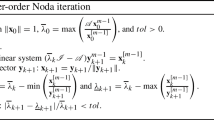Abstract
In this paper, finding the \(\mathcal {B}\)-eigenvalues of a symmetric tensor is equivalent to solving a least-square optimization problem. Based on the subspace technique, a trust region algorithm is presented. In trust region subproblem, the modified Broyden–Fletcher–Goldfarb–Shanno formula is adopted to generate the approximated matrices. In order to reduce the computation cost in each iteration, the quadratic subproblem is constructed in a subspace with lower dimension. Theoretic analysis of the given algorithm and convergence properties of the optimal solutions are established. Numerical results show that this method is efficient.
Similar content being viewed by others
References
Lim L.: Singular values and eigenvalues of tensors: a variational approach. In: 1st IEEE International Workshop on Computational Advances in Multi-Sensor Adaptive Processing, 2005, vol. 1, pp. 129–132 (2005)
Qi, L.: Eigenvalues of a real supersymmetric tensor. J. Symb. Comput. 40, 1302–1324 (2005)
Chang, K., Zhang, T.: On the uniqueness and nonuniqueness of the Z-eigenvector for transition probability tensors. J. Math. Anal. Appl. 408, 525–540 (2013)
Hao, C., Cui, C., Dai, Y.: A sequential subspace projection method for extreme Z-eigenvalues of supersymmetric tensors. Numer. Linear Algebra Appl. 22, 283–298 (2015)
Hu, S., Huang, Z., Qi, L.: Strictly nonnegative tensors and nonnegative tensor partition. Sci. China Math. 1, 181–195 (2014)
Kolda, T., Mayo, J.: Shifted power method for computing tensor eigenpairs. SIAM J. Matrix Anal. Appl. 32, 1095–1124 (2011)
Kolda, T., Mayo, J.: An adaptive shifted power methods for computing generalized tensor eigenpairs. SIAM J. Matrix Anal. Appl. 35, 1563–1581 (2014)
Kofidis, E., Regalia, P.: On the best rank-1 approximation of higher-order supersymmetric tensors. SIAM J. Matrix Anal. Appl. 23, 863–884 (2002)
Li, G., Qi, L., Yu, G.: Semismoothness of the maximum eigenvalue function of a symmetric tensor and its application. Linear Algebra Appl. 2, 813–833 (2013)
Ni, G., Qi, L., Wang, F., Wang, Y.: The degree of the E-characteristic polynomial of an even order tensor. J. Math Anal. Appl. 329, 1218–1229 (2007)
Ng, M., Qi, L., Zhou, G.: Finding the largest eigenvalue of a nonnegative tensor. SIAM J. Matrix Anal. Appl. 3, 1090–1099 (2009)
Chang, K., Pearson, K., Zhang, T.: Primitivity, the convergence of the NQZ method, and the largest eigenvalue for nonnegative tensors. SIAM J. Matrix Anal. Appl. 3, 806–819 (2011)
Qi, L., Teo, K.: Multivariate polynomial minimization and its application in signal processing. J. Glob. Optim. 26, 419–433 (2003)
Wei, T., Goldbart, P.: Geometric measure of entanglement and applications to bipartite and multipartite quantum states. Phys. Rev. A. 68, 042307 (2003)
Hao, C., Cui, C., Dai, Y.: A feasible trust-region method for calculating extreme Z-eigenvalues of symmetric tensors. Pac. J. Optim. 11, 291–307 (2015)
Cao, M., Huang, Q., Yang, Y.: A self-adaptive trust region method for extreme \(\cal{B}\)-eigenvalues of symmetric tensors. Numer. Algorithms 81(2), 407–420 (2019)
Ni, Q., Qi, L.: A quadratically convergent algorithm for finding the largest eigenvalue of nonnegative homogeneous polynomial map. J. Glob. Optim. 61, 627–641 (2015)
Yang, W., Ni, Q.: A cubically convergent method for solving the largest eigenvalue of a nonnegative irreducible tensor. Numer. Algorithms 77(4), 1183–1197 (2018)
Chang, K., Pearson, K., Zhang, T.: On eigenvalue problems of real symmetric tensors. J. Math. Anal. Appl. 350, 416–422 (2009)
Cui, C., Dai, Y., Nie, J.: All real eigenvalues of symmetric tensors. SIAM J. Matrix Anal. Appl. 4, 1582–1601 (2014)
Yuan, Y., Sun, W.: Optimization Theory and Methods. Science Press, Beijing (1997)
Wang, Z., Yuan, Y.: A subspace implementation of quasi-Newton trust region methods for unconstrained optimization. Numer. Math. 104, 241–269 (2006)
Xu, C., Zhang, J.: A survey of quasi-Newton equations and quasi-Newton methods for optimization. Ann. Oper. Res. 103, 213–234 (2001)
Nocedal, J., Wright, S.: Numerical Optimization. Springer, New York (1999)
Yang Y.: On the truncated conjugate gradient method. Report, ICM99003, ICMSEC, Chinese Academy of Sciences. Beijing, China (1999)
Moré, J.: Recent development in algorithm and software for trust region methods. In: Bachem, A., Grotschel, M., Kortz, B. (eds.) Mathematical Programming: The State of the Art, pp. 258–285. Spinger, Berlin (1983)
Nie, J., Wang, L.: Semidefinite relaxations for best rank-1 tensor approximations. SIAM J. Matrix Anal. Appl. 35, 1155–1179 (2013)
Acknowledgements
We would like to thank the anonymous referees and the editor for their valuable comments. This work is supported by National Natural Science Foundation of China (11601473), the Innovation Talent Training Program of Science and Technology of Jilin Province of China (20180519011JH), the Science and Technology Development Project Program of Jilin Province (20190303132SF), the Applied Basic Research Programs of Science and Technology Department of Yunnan Province (2018FB001), Program for Excellent Young Talents of Yunnan University, Yunnan Provincial Ten Thousands Plan Young Top Talents, the Doctor Research Startup Project of Beihua University (170220014).
Author information
Authors and Affiliations
Corresponding author
Additional information
Communicated by Anil Aswani.
Publisher's Note
Springer Nature remains neutral with regard to jurisdictional claims in published maps and institutional affiliations.
Rights and permissions
About this article
Cite this article
Cao, M., Huang, Q., Li, C. et al. A Subspace Modified Broyden–Fletcher–Goldfarb–Shanno Method for \(\mathcal {B}\)-eigenvalues of Symmetric Tensors. J Optim Theory Appl 184, 419–432 (2020). https://doi.org/10.1007/s10957-019-01617-5
Received:
Accepted:
Published:
Issue Date:
DOI: https://doi.org/10.1007/s10957-019-01617-5
Keywords
- Symmetric tensors
- \(\mathcal {B}\)-eigenvalues
- Modified Broyden–Fletcher–Goldfarb–Shanno
- Subspace technique
- Global convergence




